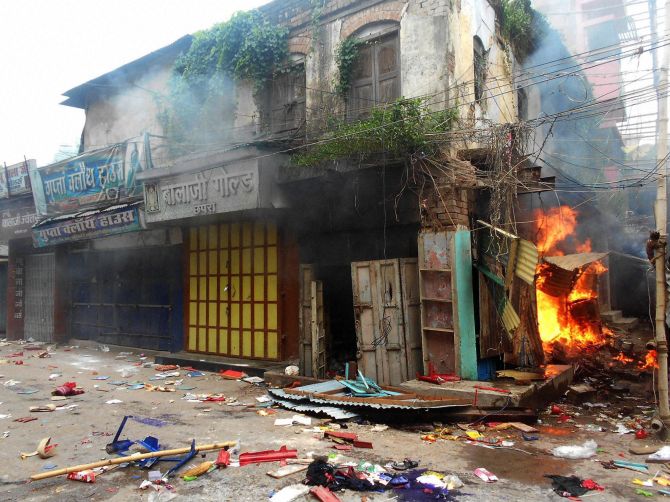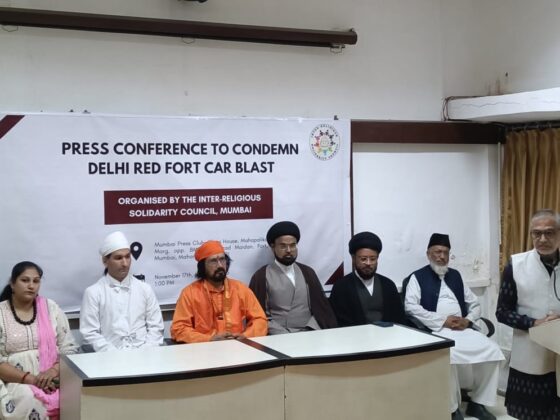A Report by CSSS[1]
07/11/2025
“The Congress and RJD have committed the sin of dividing the society of Bihar. The RJD pushed Bihar into communal riots, the Congress triggered religious riots…,” said the Prime Minister during the election campaign in Bihar (Indian Express, 2025). However, data on communal riots in Bihar suggests otherwise.
| Ruling Regime | Total Communal Riots | Total Deaths | Average Communal Riots/Year | Average Deaths/Year |
| RJD (1990-2004) | 16 | 80 | 1 | 5.3 |
| JDU (2005-2025) | 46 | 17 | 2.3 | 0.85 |
According to the monitoring of Centre for Study of Society and Secularism (CSSS) based on newspaper reports, the period from 2005 to 2025 marked by Nitish Kumar and Janata Dal (United) party [2]in power in Bihar witnessed 46 communal riots and 17 deaths related to communal riots. This amounted to an average of 2.3 riots per year and 0.85 deaths per year.
This contrasts with 16 communal riots and 80 deaths when Lalu Prasad Yadav- Rabri Devi[3] government was in power from 1990 to 2005. The average riot in this period was 1 riot per year and 5.3 deaths per year when Sitamarhi riot is taken into consideration and 2.1 deaths per year without accounting for 48 deaths in Sitamarhi alone.
This marks a 188% increase or almost three times spike in the communal riots in the period 2005 to 2025 compared to 1990-2005.
The state of Bihar is in the midst of the biggest exercise of democracy- that is the state elections. All eyes are glued to the electoral outcome in Bihar in the backdrop of the Special Intensive Revision (SIR), the constant shifting political alliances and the incumbent’s promise of an end to the ‘Jungle Raj’ (lawlessness) in Bihar. One of the important aspects to end this Jungle Raj is addressing this lawlessness within Bihar’s complex socio-political landscape—characterized by entrenched caste and religious fault lines—is the management and mitigation of communal riots. According to the study of eminent scholars Ashutosh Varshney and Steven Wilkinson, Bihar was amongst the top five states in India recording highest number of deaths during Hindu-Muslim riots in the period 1960 to 1993, making it one of the worst affected states in India (Varshney & Wilkinson, 1995).
One notices a change in this situation after 1990 when Lalu Prasad Yadav-Rabri Devi government took over the reins and was in power till 2005. During this period there was a drastic drop in communal riots as compared to the previous regimes. One of the major riots during this period was in Sitamarhi in 1992, in which 48 people were reportedly killed. However, it is believed that Lalu Prasad Yadav himself camped at Sitamarhi to bring the situation under control, demonstrating his strong political will. During 1990 to 2005, Bihar saw 16 communal riots and 80 deaths during riots. The success of Lalu Prasad Yadav can be attributed in some measure to two factors – his political formula of stitching together a support base of Yadavs and Muslims and secondly, his unambiguous instructions to the administration, threatening penal consequences if riots occurred under their watch.
During the period 2005- 2025, the patterns of communal riots changed. Though the number of communal riots as compared to 1990-2004 spiked, they were less fatal in terms of number of deaths. Though there were 46 communal riots in 20 years, there were 17 deaths in these riots indicating that the administration could control communal riots and prevent them from assuming a larger scale.
Triggers for Communal Riots:
Majority of communal riots in both the regimes were triggered by religious processions and festivals. Out of 16 communal riots that took place during 1990 and 2004, nine communal riots (56 percent) were related to religious festival or procession including immersion of Durga idol, Saraswati Puja procession, Tazia procession and Eid, highlighting how religious festivals have been triggers for communal riots and how public spaces are increasingly become places for contestation and hegemony.
This trend is visible in the period of 2005 to 2025 where out of 46 communal riots, 29 communal riots (63 percent) were related to religious festivals and processions. It is important to note that the Hindu right wing and at times, BJP leaders, directly have participated actively in the violence during processions. The other triggers include desecration of temples, dispute over graveyard and personal enmity.
It is observed that during 2005 to 2025 where BJP was in alliance with JDU, the number of communal riots triggered by religious processions increased to 63% compared to the period 1990-2004 where 56% of communal riots were triggered by religious processions.
Religious Processions, Polarization and Electoral Dividends:
It is interesting to note that scholars including Christophe Jaffrelot, who have studied communal riots have pointed out that religious processions have been used by Hindu right to gain electoral dividends. Before elections, religious processions and related violence have helped in polarization along religious lines. This also reflects in the steady rise of the BJP seats and vote share in Bihar over the years.
For instance, the number of seats of BJP in 1990 state elections was 39 and had 11% of vote share. This increased to 41 seats and 13% vote share in 1995 state elections, 67 seats and 14% vote share in 2000 and 55 seats and 15.56 % of vote share in 2005, 91 seats and 16% vote share in 2010. Ironically in 2015, the BJP seats fell to 53 and vote share increased to 21%. In 2020, though BJP’s vote share dropped to 19%, the number of seats rose to 74
| YEAR | NO. OF SEATS WON BY BJP IN STATE ASSEMBLY | BJP VOTE SHARE IN STATE ASSEMBLY |
| 1990 | 39 | 11% |
| 1995 | 41 | 13% |
| 2000 | 67 | 14% |
| 2005 | 55 | 15.65% |
| 2010 | 91 | 16.49% |
| 2015 | 53 | 21.81% |
| 2020 | 74 | 19.46% |
Theatre of violence:
The data indicated that some areas in Bihar have been hotspots of communal violence. For instance, Nalanda district (includes Bihar Sharif), Munger and Darbhanga district accounted for eight communal riots out of 16 communal riots from 1990 to 2004.
| District | Number of Communal Riots |
| Darbhanga | 2 |
| Nalanda | 4 |
| Munger | 2 |
From 2005 to 2025, Nawada, Bhojpur, Sitamarhi, Chappra, Bhagalpur and Sasaram among other districts emerged as communal hotspots.
| District | Number of Communal Riots |
| Navada | 4 |
| Bhojpur | 3 |
| Sitamarhi | 3 |
| East Champaran | 2 |
| Chhapra | 2 |
| Samastipur | 2 |
| Aurangabad | 2 |
| Bhagalpur | 2 |
| Sasaram | 2 |
| Siwan | 2 |
| Darbhanga | 2 |
| Sheikhpura | 2 |
So far as communal riots are concerned, which regime is truly marked by the Jungle Raj?
Reference:







